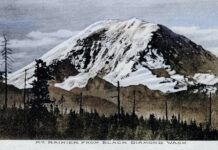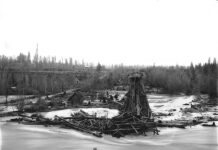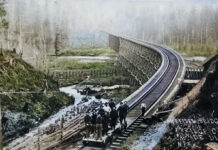Two weeks ago, this column featured a view looking north along Enumclaw’s Cole Street sometime in the 1940s or 1950s. This week’s photo was taken decades earlier from a vantage point one block further south at Cole Street’s intersection with Stevenson Avenue. The image comes from a postcard mailed in 1911, but this street-scene photo was likely taken before 1909.
Note how Coal Street is printed in the upper left-hand corner. The original spelling came from the fact that if extended northward along the Northern Pacific Railroad tracks, the street would intersect Coal Creek. That stream flows from the sawed-off promontory where a “thundering noise” was heard by Native Americans giving Enumclaw its name. The street’s spelling was later changed to Cole.
The first building on the right was Rochdale Company, one of the town’s most important early businesses. In 1905, local citizens including Joshua A. Morris, Eugene Cota, Charles Johnson, James Montgomery, J.P. Jones, John Fleming, and Louis Nicholas organized a farmers’ cooperative store. They named it Rochdale in honor of the town in England where tradesmen jointly acquired and resold food items and other goods they could purchase more cheaply in bulk. The Rochdale Principles provided bylaws through which many consumer co-operatives evolved. Enumclaw’s Rochdale eventually sold groceries, dry goods, furniture, hardware, farm equipment, and implements. Carl Johansen’s meat market was added in 1940, but Rochdale’s went out of business in 1955.
The Rochdale building was purchased and completely remodeled by local investors and grocery-men George Kranc, Walter Yonkers, Pete Kranz, Bill Dunning, and Jim Arnette. Rochdale Co-operative became the Enumclaw Food Center that served the community until the late 1980s when the structure was demolished. Today the site is a parking lot owned by the city and features the popular statue of a horse on the southeast corner of Cole Street and Initial Avenue.
Across the street from Rochdale, next to the billboard advertising wallpaper, paints, and oils was a then-vacant lot with a white fence. When this postcard was mailed to Mr. D.H. Courtney of Dole, Washington, a tiny berg in Clark County, his correspondent noted that the white fence was where he watched a horse race, presumably staged down Enumclaw’s main street. Cole Street wasn’t paved until 1915. The postcard writer also said the space behind the fence was where the new opera house stood.
The Rialto Opera House was formerly the Griffin and Blake store owned by Arthur Griffin and John Blake. Griffin was from Minnesota and came to Enumclaw with the original survey crew over Stampede Pass where the railroad would soon locate. Blake was a schoolteacher from Iowa. Blake and Griffin were the first guests at a boarding house built by Frank and Mary Stevenson, Enumclaw’s founding couple.
The Griffin & Blake store building was purchased and moved to the location opposite Rochdale’s by Joe Krulikoski in March 1909. Krulikoski outfitted the building with a showhouse, dance hall, and skating rink that became Enumclaw’s entertainment center. Gene Groesbeck was Enumclaw’s “Mr. Movies” and rented Krulikoski’s showhouse where films were projected by a hot carbide arc lamp that might have caused the fire that destroyed the Rialto Opera House in 1914. Later, Groesbeck built the Liberty Theater on Wells Street. Liberty was torn down in 1952 at what is now the location of the Enumclaw Police Department. The next building south on Wells was at first a Legion Hall, then became the Roxy Theater whose name was changed to the Chalet Theater in November 1970.
This postcard photo comes courtesy of JoAnne Matsumura, an Issaquah historian, while photo enhancements were performed by Boomer Burnham, a Tahoma photography instructor.







